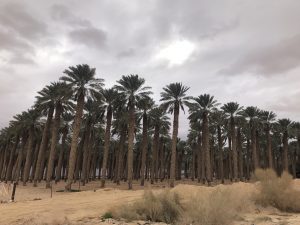Greetings readers! In the fall semester of 2019, Jenn Halpin and I co-taught a course called Food and Energy in the USA and Israel. We had a great classroom full of students from many disciplines, as the course was cross listed in Food Studies, Environmental Studies, International Studies, and Middle Eastern Studies. Of the 24 students in the course, nine adventuresome travelers signed up for a culminating experience in Israel for the next two weeks. From today until January 19th each member of our group will provide daily updates on this blog on a rotating basis.
The curriculum for the fall course was a broad-spectrum comparative look at food and energy issues in both countries, ranging from Kosher and Halal foods, sustainable farming practices and water resources to hands-on lab exercises in solar and bioenergy production. Also included for context was a deep dive into historical, contemporary and personal aspects of the Israeli-Palestinian conflict. Each student wrote a research paper on a topic of their choosing. Students on the current trip to Israel are here to gain first-hand exposure to food and energy material in-country and are tasked with furthering their investigations into the Israeli side of their paper topics. Our tour, spanning the country from south to north, will include numerous sites of interest and contact with a wide variety of sources, from academic experts in the field to hands-on practitioners of the food and energy trades.
Today is our first full day in Israel. Our trip thus far has been smooth sailing. All students who flew in as a group met on time at JFK airport, and our ten-hour flight was happily uneventful. After we cleared customs, two students who arrived early to visit family members in Israel (Amelia and Josh) met us at the Tel Aviv airport and we found our Israeli bus driver for a quick exit of the busy city. About an hour south of Tel Aviv, we stopped for our first Israeli falafels at a highway rest stop. Thankfully Josh and Amelia could read the menu! (The gas station falafels were fine – a good start to my personal quest for the perfect falafel sandwich – a baseline above which we can only improve.) Following lunch we all passed out from jet lag for a few hours of bus ride and woke up in the Negev desert of southern Israel. We fell asleep in a semi-arid but green landscape (it has been raining a lot in recent weeks up north) and came to in the brown and tans hills of the Arava valley, dotted here and there with date palm groves. To the east we can see the dry hills of Jordan and from the south we can almost smell the ocean air of the Red Sea coast at Eilat.
Our home for the next four nights is Kibbutz Ketura, a wonderfully productive oasis in the desert. Ketura is home to the Arava Institute for Environmental Studies (AIES), a Dickinson partner program in Israel. The AIES offers undergraduate and graduate coursework in renewable energy, sustainable agriculture, water management, ecology, and peace building, all with a trans-boundary focus. The student mix at the AIES is 1/3 Israeli, 1/3 Palestinian and Jordanian, and 1/3 internationals from a variety of countries including the US. The core goal of AIES curriculum is building trust among historically opposing parties in the Middle East through dialogue and solutions-based approaches to regionally shared resource issues. In addition to a long-standing connection with Dickinson (several students from the College have studied abroad at the AIES), the program’s constructive approach to sustainability and conflict resolution fits perfectly with the offerings and philosophy of the College Farm.
Today was all about orientation, including a tour of Ketura with an introduction to Kibbutz life, lectures by experts in renewable energy and intercultural land-use issues, and three meals in the communal dining hall (lots of fresh salad, no deserts, plenty of tahini, very healthy!). We are grounding ourselves in the desert among welcoming, interesting people. It is exciting to hear their stories, to hear and see Hebrew all around us, and to immerse ourselves in a culture that is both foreign and familiar. We are well housed, well fed, and all of the students in the group have great attitudes! Happily, despite the unfortunate escalation in US-Iranian conflict that came to a head just prior to our departure, everything is calm and quiet in Israel and our hosts have reassured us that we can rest easy here in the Arava valley.
Thanks for reading! Please stay tuned for more interesting and exciting posts each day.
Cheers
Matt Steiman (Co-Instructor and College Farm Co-Manager)





